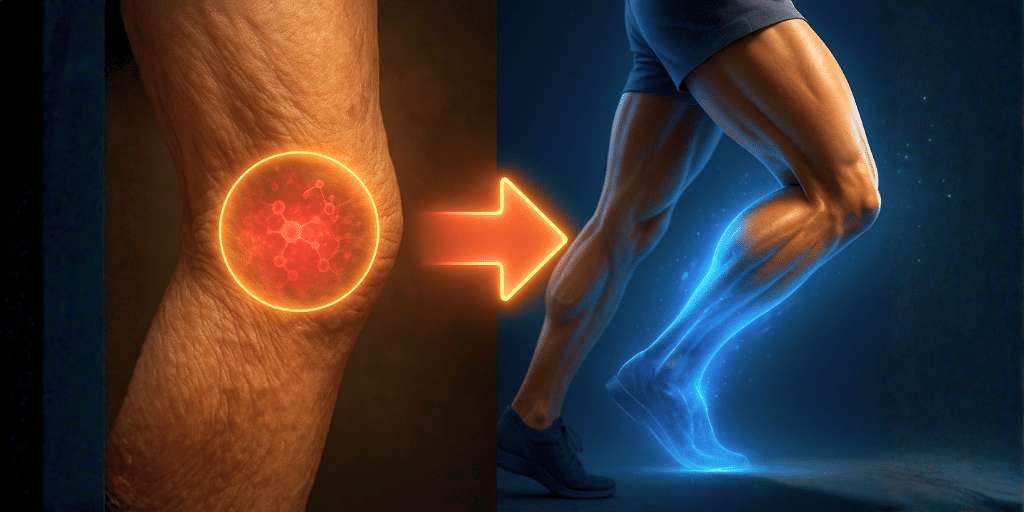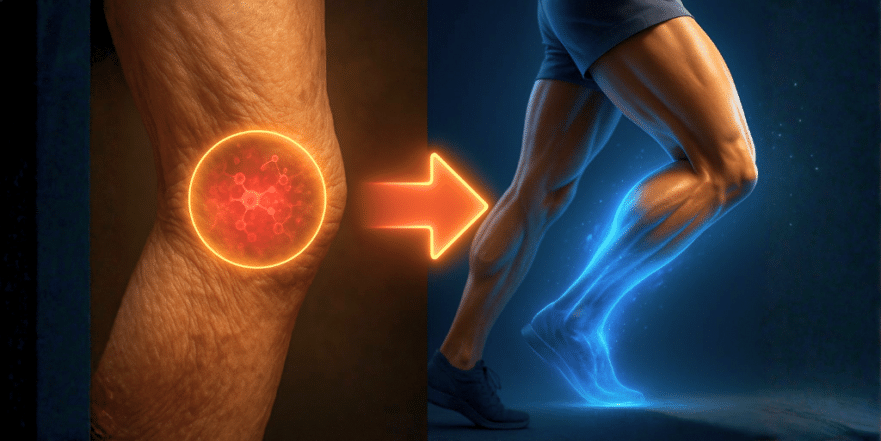
Have you noticed that you’re losing strength, almost without realizing it? Climbing stairs takes more effort, you get up from a chair a little slower, and you might just think, “Well, it must be my age,” or maybe, “I’m not getting enough protein.” And yes, protein is absolutely essential, but it’s not the whole story. You can have all the bricks in the world, but if there’s no one there to lay them, the muscle simply won’t get built. Here’s an uncomfortable truth: it’s not just about age. Your muscles start to “turn off” when they stop receiving what they need. And I’m not just talking about food; I’m talking about signals—signals of movement, rest, and strategy.
Why does this matter so much? Because your muscle strength isn’t a luxury. It’s the very thing that allows you to move freely, maintain your balance, and live an independent life. Losing it isn’t a foregone conclusion of aging; it’s a condition called sarcopenia, and the good news is that you have incredible power to fight it. In this article, we’re going to dive deep into what truly works to recover your strength, especially after 60. We’ll debunk the common myths that are secretly robbing you of your vitality and give you a practical, step-by-step guide to start rebuilding your muscle and reclaiming your power, starting today. (Based on the insights of Dr. Alberto Sanagustín)
Key Takeaways
- Sarcopenia is Reversible: Age-related muscle loss is common, but it is not an irreversible fate. With the right strategies, you can slow, stop, and even reverse it.
- Protein Isn’t Enough: While protein is the building block of muscle, it needs a clear signal to be used. That signal comes from resistance exercise.
- It’s More Than Just Exercise: True strength is built on five pillars: Muscle Activation, Strategic Nutrition, Nerve Health, Calming Inflammation, and Bone & Joint Support.
- Avoid Common Mistakes: Simple errors like eating all your protein at once, neglecting hydration, or getting poor sleep can sabotage your efforts.
- Consistency Beats Intensity: You don’t need to become a bodybuilder. Small, consistent, and progressive actions are the key to long-term strength and health.
1. What is Sarcopenia, and Why Does It Really Happen?

Sarcopenia might sound like a complicated medical term, but it simply describes the progressive loss of muscle mass and strength that comes with age. The surprising part is that this process doesn’t start at 70; it often begins quietly in our 40s. At first, it’s so slow you barely notice it—like a silent, slow water leak. But after age 60 or 65, something changes. The rate of loss accelerates. The leak becomes a steady drip, and what was once a minor weakness turns into a real difficulty with walking, standing up, or even opening a jar. Many people accept this as a normal part of getting older, but that’s not the whole truth.
While your body does change over the years, you are not programmed to automatically become weak. What really happens is that after a certain age, your body needs more stimulus to maintain the same amount of muscle. If you don’t provide that stimulus in the form of proper nutrients, movement, and rest, your muscles essentially say, “Why should I stick around if you’re not using me?” and they begin to waste away. This isn’t about vanity; it’s about your autonomy, your balance, and your quality of life. When you lose muscle, you lose confidence, you’re more prone to falls, you recover more slowly, and you fatigue more easily. But here’s the best news of all: sarcopenia can be stopped and, in many cases, reversed.
2. 5 Common Myths That Are Secretly Sabotaging Your Strength

Before we build, we have to clear the ground of bad information. Sometimes, the very things you think are helping you are actually making the problem worse. It’s not that there’s a lack of information out there, but often we’re only told half the story. Let’s bust some of the most frequent myths that might be weakening your muscles without you even knowing it.
- Myth #1: “If I just eat more protein, I’ll be fine.”
Yes, protein is non-negotiable. You cannot have muscle synthesis without enough protein. The problem? Piling your plate with chicken breasts or chugging protein shakes won’t do much if your muscles don’t receive a clear order to grow. It’s like having a stack of bricks (the protein) but no bricklayer (the exercise) to put them in place. You need both. Without the stimulus of resistance, there is no signal to build. - Myth #2: “A supplement will solve my problems.”
Many people think a magic pill or powder—creatine, whey protein, collagen capsules—is the answer. Can they help? Yes, they can be supportive. Are they essential? No. And do they work without movement? Almost never. Creatine, for example, has excellent research behind it, but it delivers the best results when combined with strength training. Supplements should only be used if you know exactly why you’re taking them and, ideally, with professional guidance. - Myth #3: “It’s normal to lose strength because of my age.”
It’s common, but it’s not normal or inevitable. There are 80-year-olds who climb stairs with ease and 60-year-olds who feel they can’t keep up with their own bodies. Age is a factor, but your lifestyle is a much bigger one. Your body doesn’t have an expiration date; it has a stimulus threshold. If you don’t cross that threshold, you will go backward. - Myth #4: “Eating ‘healthy’ is enough.”
This depends entirely on what you mean by “healthy.” For some, it means eating “lightly”—a bit of fruit, some whole-wheat crackers, a small salad. But if you’re not giving your body sufficient protein, healthy fats, key minerals, and enough overall energy, it lacks the raw materials for structure. It’s like trying to repair a house with only electricity but no lumber, cement, or nails. - Myth #5: “Walking is enough exercise.”
Walking is fantastic for your heart, your mood, and your general mobility. But to rebuild muscle strength, you need more. Your muscles need resistance, a load, a challenge. We’re not talking about lifting heavy weights at a gym. We’re talking about simple things: getting up from a chair 10 times in a row, stepping up and down on a single stair, or even just holding your own body weight for a little longer each day. That is how you send the right signal.
3. The 5 Pillars That Truly Rebuild Muscle After 60

The answer to regaining strength isn’t found in a single superfood or a miracle workout. It’s about a combination of key elements that, when brought together consistently, can transform your body. Think of them as the five pillars of a house. If one fails, the whole structure becomes unstable. Here are the five pillars you can start building from your own kitchen and living room.
- Pillar #1: Activate the Muscle (Even a Little Bit)
Your muscle needs an excuse to stay, and that excuse is called resistance. It’s effort. It’s movement against a force. This doesn’t mean you need to join a gym. It means creating a small challenge for your body to overcome. Examples include: getting up from a chair without using your arms, using a bottle of water as a weight, or pushing firmly against a wall or table. This sends the signal: “I still need this muscle!” This concept is called progressive overload. You start with what you can do, and little by little, you add a bit more. This not only activates muscle but also strengthens bones and joints. - Pillar #2: Nourish the Muscle with Strategy
Protein is the raw material, but the key is how, how much, and when. A crucial amino acid called leucine—found in eggs, meat, yogurt, and soy—acts like the construction foreman, giving the order to build. For this to work, you need to: 1) Eat complete proteins with all essential amino acids. 2) Spread your protein intake throughout the day, rather than saving it all for dinner. 3) Combine it with complex carbohydrates and micronutrients for energy and function. For example, a breakfast of eggs and oatmeal, a lunch of lentils and rice, and a dinner of fish and potatoes. This way, you stimulate muscle synthesis multiple times a day. - Pillar #3: Care for the Nervous Connection
Many people think losing strength is just about losing muscle, but sometimes the problem is in the “wiring.” Your muscles won’t activate properly if your nerves are slow, inflamed, or malnourished. For this, you need key nutrients: magnesium (pumpkin seeds, almonds, spinach), potassium (bananas, potatoes, squash), healthy fats (avocado, walnuts, olive oil), and B-vitamins. These are best found in whole, real foods. If this connection is weak, you might experience tremors, cramps, or clumsiness. This isn’t just weakness; it’s a signaling problem that can be improved with nutrition. - Pillar #4: Calm Chronic Inflammation
Silent, chronic inflammation is like an internal handbrake on your body. It makes muscle repair more difficult and leaves you feeling tired, irritable, and weak. There is no single miracle anti-inflammatory food, but an overall dietary pattern can help put out this internal fire. This includes eating plenty of berries, fatty fish (like salmon and sardines), a wide variety of vegetables, and spices like turmeric (with black pepper). Just as important are lifestyle factors: getting good sleep, moving daily, staying hydrated, and reducing stress. Your body doesn’t just feed on food; it feeds on rest. - Pillar #5: Support Your Bones and Joints
Your muscles don’t exist in a vacuum; they need a strong frame to attach to. If your bones are weak or your joints hurt, you’ll move less, and your muscles will decline faster. This is where calcium and vitamin D come in (from dairy, sardines, and sun exposure). Gentle, weight-bearing movement is also crucial for bone strength. Homemade bone broth can be nutritious and comforting. Remember, movement doesn’t just maintain muscle; it lubricates joints and, by strengthening the muscles around them, can actually reduce joint pain.
4. Your Simple, Practical Weekly Plan to Regain Strength
Theory is one thing, but facing your kitchen after a long day is another. The goal is to make this simple, realistic, and sustainable. Here are three sample daily plans to show you how to combine these principles without obsession or expensive supplements. Click NEXT to see plans.

